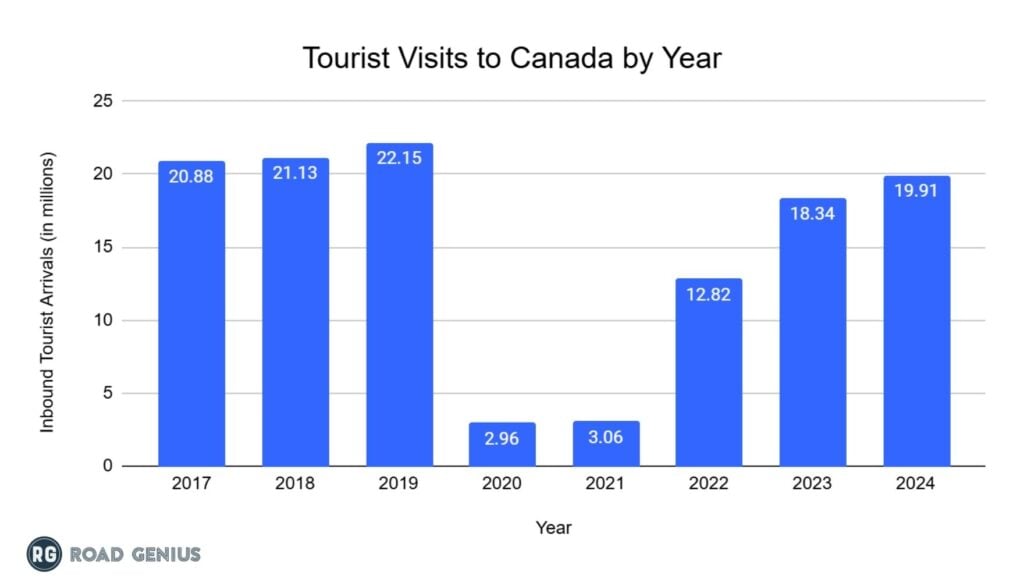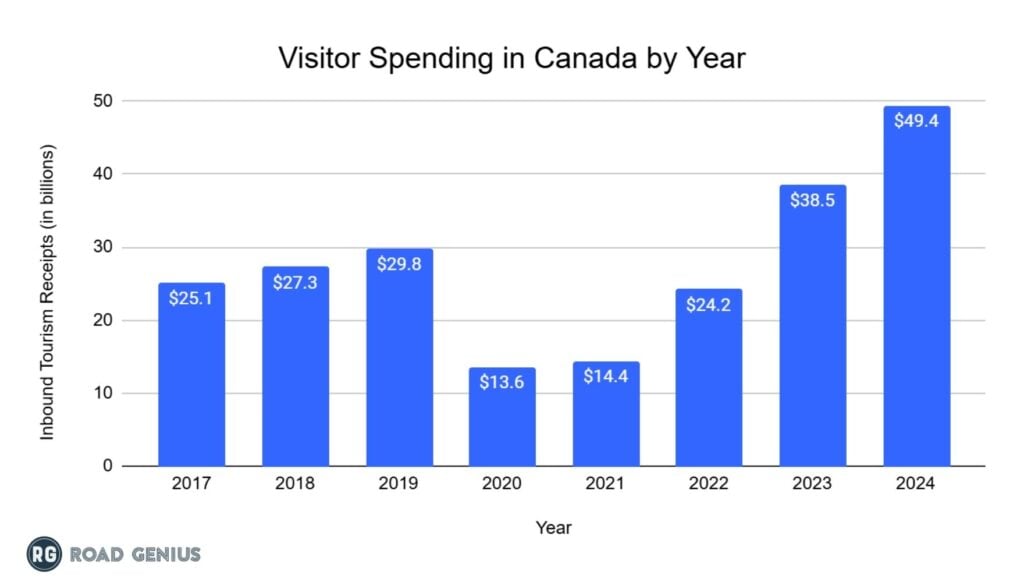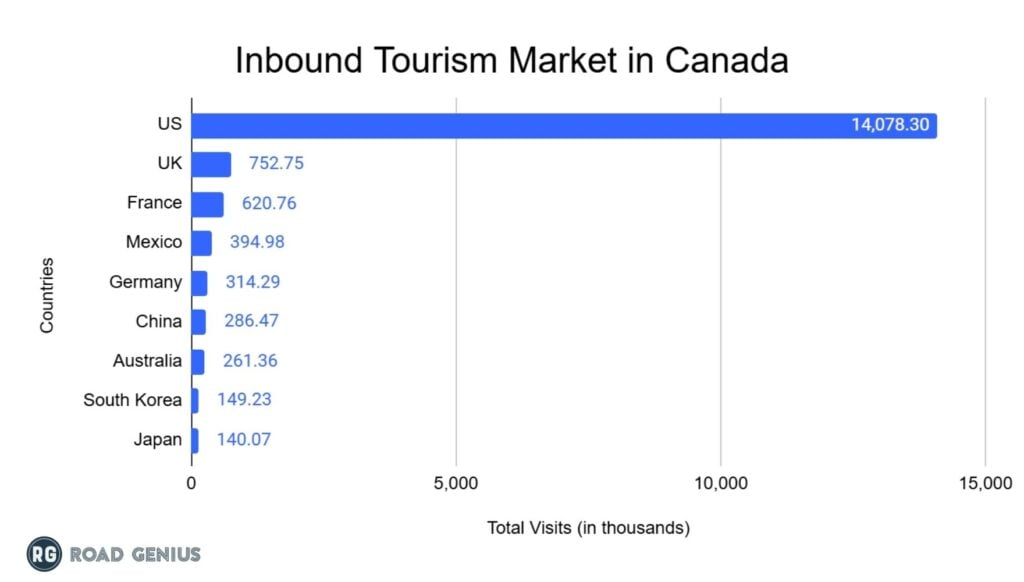Page last updated: 05 May 2025
As the second-largest country in the world, Canada draws millions of visitors each year with its natural landscapes, diverse and welcoming cities, rich multicultural heritage, and historical sites.
How many tourists visit Canada each year?
About 20 million international visitors travelled to Canada every year before the pandemic.1 In 2024, a total of 19.91 million people visited Canada.
- International visitor arrivals in Canada steadily increased from 20.9 million in 2017 to 22.1 million in 2019.
- In 2020, the pandemic caused a sharp decline in tourism, with arrivals dropping to 3 million visitors. This only slightly increased in 2021 to 3.1 million visitors.
- By 2022, Canada’s tourism sector showed signs of recovery with 12.8 million international visitors, and in 2023, arrivals further increased to 18.3 million, though still below pre-pandemic levels.2
- Arrivals increased to 19.91 million visitors in 2024, representing an 8.6% increase from the previous year.

How many tourists visited Canada in 2025?
- Canada recorded approximately 870,000 overnight arrivals by all modes in January 2025, representing a 13% increase from the same period in 2024.
How many people visited Canada in 2024?
Approximately 19.91 million international tourists visited Canada in 2024. This represents an 8.6% increase from the previous year but remains approximately 10% below the pre-pandemic peak.
How many tourists visited Canada in 2023?
In 2023, approximately 27.2 million international visitors travelled to Canada.
- This number more than doubled from the 12.8 million visitors recorded in 2022 and represented a 23% increase compared to the 22.1 million visitors before the pandemic.
How many people visited Canada in 2022?
Throughout 2022, over 12.8 million tourists visited Canada.
- This was a 319% increase from 3.1 million in 2021 but was still 42% less when compared to pre-pandemic levels (22.1 million visitors).
How much do visitors spend in Canada every year?
Visitors spent between $25 billion and $30 billion annually before the pandemic, with spending reaching a new record of $49.4 billion in 2024.
- In 2017, international visitors spent $25.1 billion in Canada. This increased to $29.8 billion in 2019, reflecting steady growth in the tourism sector.
- Mirroring the decrease in tourist arrivals, visitor spending dropped to $13.6 billion in 2020, followed by a slight increase to $14.4 billion in 2021.
- By 2022, tourism spending rebounded to $24.2 billion, about 81% of the 2019 level.
- In 2023, spending in Canada climbed to $38.5 billion, reflecting a strong recovery in the tourism sector.
- In 2024, spending in Canada climbed to $49.4 billion, representing a 28.3% increase from the previous year, which totalled $38.5 billion.
Note: This revenue figure represents the total economic contribution of the tourism sector, including domestic travel and related industries, differing from direct international visitor spending.

How much do people spend in Canada in 2024?
A total of $49.4 billion was spent by tourists visiting Canada in 2024. This represents a 28.3% increase from the previous year and exceeded the pre-pandemic peak of 2019 by 65.8%.
How much did tourists spend in Canada in 2023?
Visitor spending in Canada reached $38.5 billion in 2023, setting a new record.
- This was a 59% increase from the $24.2 billion spent in 2022 and a 29% increase from the $29.8 billion spent in 2019.
How much did tourists spend in Canada in 2022?
Visitors spent $24.2 billion in Canada in 2022.
- This was a 68% increase over the $14.4 billion spent in 2021, but still approximately 19% down compared to 2019 (pre-pandemic).
How much money does Canada make from tourism?
- In 2023, Canada’s tourism industry generated approximately $109.5 billion in revenue, surpassing pre-pandemic levels.
- The sector is vital to the economy and is expected to continue growing in the coming years, potentially reaching $160 billion by 2030.3
Impact of Coronavirus – Canada Tourism Statistics 2020 and 2021
- In 2020, Canada saw a sharp decline in tourism due to the COVID-19 pandemic, with only approximately 3 million international visitors, down from 22.1 million in 2019 (a decrease of approximately 86%). In 2021, the number of visitors increased slightly to 3.1 million, reflecting a minimal recovery but still far below pre-pandemic levels.
- Visitor spending in Canada mirrored this decline. In 2020, spending dropped to $13.6 billion, a 54% decrease from the $29.8 billion spent in 2019. In 2021, visitor spending saw a slight increase to $14.4 billion, representing a 6% rise from 2020, but still well below the 2019 level.
What countries visit Canada the most?
- The United States is the leading source of international visitors to Canada, with a total of 14 million tourists in 2024.
- This was followed by the United Kingdom with 752,750 tourists.
- France (620,760), Mexico (394,980) and Germany (314,290) also contributed a significant share of the market.4

How popular is Canada as a tourist destination?
- In 2023, Canada ranked 18th globally in tourist arrivals, welcoming approximately 18.34 million visitors.
- The country also performed well in terms of revenue, ranking 10th in tourism receipts, generating around $38.5 billion.
- Additionally, Canada was ranked 11th in tourism exports, with the same figure of $38.5 billion.
Canada Travel Resources
- Car hire prices in Canada or (Campervan)
- Car hire prices in Calgary or (Campervan)
- Car hire prices in Toronto or (Campervan)
- Car hire prices in Vancouver or (Campervan)
When is the peak tourist season in Canada?
The peak tourist months in Canada are from May to September in 2024, driven by favorable weather, festivals, and school holidays.
- July and August had the highest international tourist arrivals at 2.92 million and 2.70 million respectively.
- June, September, and May also see strong numbers, rounding out the top 5 peak months for international visitors.

When is the best time to visit Canada?
- Summer (June to August) is the most popular time, offering warm weather and numerous festivals. This is ideal for exploring cities and national parks and enjoying outdoor activities.
- Fall (September to November) is also a good time, with fewer crowds, pleasant weather, and beautiful autumn foliage.
- Winter (December to February) is best for those interested in winter sports like skiing and snowboarding, particularly in regions like the Rockies.
When is the best time to visit Niagara Falls in Canada?
- The best time to visit Niagara Falls is during the summer months (June to August) when all attractions are open, and the weather is warm.
- However, to avoid the peak crowds and still enjoy good weather, late August to September is ideal.
When is the best time to see the Northern Lights in Canada?
- The best time to see the Northern Lights in Canada is during the winter months (December to March) when the nights are long and dark.
- September and October can also offer good chances, especially in more remote northern areas.
- Locations like Yellowknife in the Northwest Territories and Whitehorse in Yukon are particularly known for their clear skies and frequent Aurora Borealis displays.
What are the best places to visit in Canada?
- Niagara Falls: One of the most popular tourist destinations in the country that attracts approximately 13 million visitors annually.
- Vancouver: Famous for its mild climate and beaches, Vancouver sees around 10.3 million visitors each year.
- Banff National Park & the Rocky Mountains: Known for its landscapes and turquoise lakes, Banff attracts over 4 million visitors annually.
- Toronto’s CN Tower: An iconic landmark with panoramic views, the CN Tower welcomes around 1.5 million visitors annually.
- Polar Bears of Churchill: A top spot for polar bear sightings, Churchill draws 10,000 to 15,000 visitors annually.
Canada Statistics Resources
America Travel Statistics Resources
- Mexico Statistics (incl. Cancun)
- Panama Statistics
- Peru Statistics (incl. Machu Picchu)
- USA Statistics
References
- UNTWO: Key Tourism Statistics – Global and Regional ↩︎
- DestinationCanada: Traveller Arrivals from International Markets ↩︎
- DestinationCanada: Annual Tourism Outlook ↩︎
- OECD: Tourism Trends and Policies 2022 – Canada ↩︎
